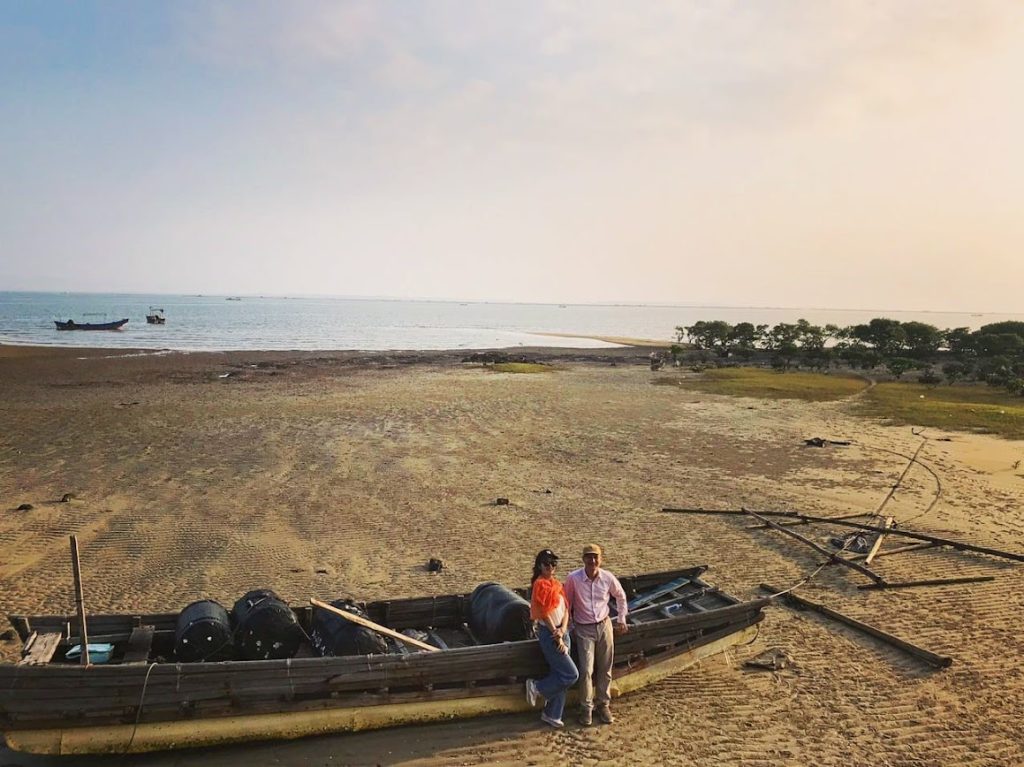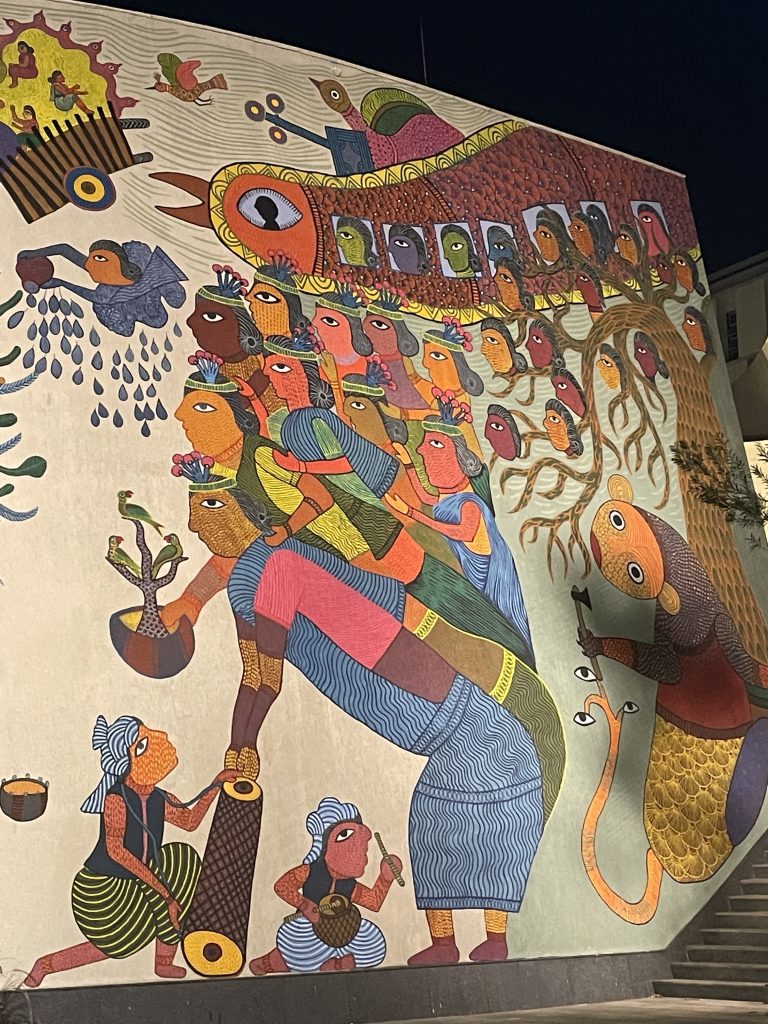It’s 6am and I’m on my way to check out the tuna landings at a jetty in the Andaman and Nicobar Islands, India. In front of me a man walks determinedly past the piles of nets and row upon row of tuna. He’s talking animatedly into his cellphone while in his other hand he has a giant cleaver. Curious to see where he’s going, I follow the man until he stops near a lower part of the jetty where instead of rows of tuna, there are more than two dozen Mobulid rays of varying sizes laid out.
Collectively referred to as Mobulids, Manta and Devil rays are large cartilaginous fishes that are closely related to stingrays. There are 8 species within the family Mobulidae, and of these, the Reef and Oceanic Manta rays have received lots of attention from conservation groups. Manta rays are bigger than their Devil ray cousins and have mouths that are positioned right up front in their head as opposed to a little further back in Devil rays. Mantas also have large club shaped appendages at the end of their heads which they use to funnel plankton into their mouths while they swim. The feeding appendages on Devil rays are thinner and curl into long spirals when they aren’t being used for feeding. These ‘horns’ on the not-so-evil Devil rays’ heads have led to their incongruous name.

Despite the greater number of devil ray species (6) the two species of Mantas continue to steal the limelight. Manta rays are revered by certain maritime cultures, considered charismatic in some parts of the world, and have been iconized as saviours and villains in books and comics such as Girl from the Sea of Cortez and Aquaman. Mobulids, and especially Mantas, are receiving a lot of attention from scientists and conservationists. Recently the entire taxonomic classification of the family was revised, with the genus Manta being dissolved and the number of previously recognized species cut from 11 down to the present 8. Even with this new genetic evidence, there is still a lot we don’t know about Mobulids and their populations due to poor monitoring leading to uncertainties about population trajectories. With some of the lowest fecundity rates amongst the world’s sharks and rays, even low levels of fishing pressure can rapidly deplete Mobulid populations.
Alongside the jetty, in a boat that has already unloaded its tuna catch, three fishermen struggle to hold aloft and weigh a Mobulid ray that has a wingspan longer than a man. A trader examines the weighing scale, declares the weight to be 90kg and tells the boat owner standing close by that he’ll pay Rs 2700 (US$ 42) for the whole ray. The boat owner agrees and his crew toss the ray onto the jetty to join the pile of other rays that are being decapitated. A man, dodging a flying ray body, sees me, grins, and says “It’s great that at least the meat now has some price and that profits can be made by landing the rays. In the past, we would just have tossed these rays back alive into the sea because they had no value, took up deck space, and barely anyone would eat them”.
Targeted small-scale fisheries for Mobulid flesh have existed for centuries in places like Indonesia, Philippines, Mexico, and Taiwan. While Mobulids may have been caught using spears and harpoons, they were also caught as bycatch in nets targeting other marine species. Recreational fisheries have also existed in parts of the world – Teddy Roosevelt during his presidency in 1916 harpooned two Giant Oceanic Manta rays off Florida. Presently, there are thirteen fisheries in 12 countries that specifically target Mobulids, and thirty fisheries in 23 countries where Mobulids are caught incidentally alongside other target species. The leading example of fisheries with incidental Mobulid catches are tuna purse- seiners. Mobulid meat has historically had a low value, involving only local sales, causing fisheries for them to be geographically restricted. But the new targeted Mobulid fisheries that have arisen in countries like Sri Lanka, India, Mozambique, and Egypt, catch Mantas and Devil rays not only for their meat, but also for their highly valued gill plates.
The man I was following earlier finishes his cellphone conversation, places his phone in a pocket, nods to a friend who is crouched near the rays, and bends down to get to work, cutting off a Mobulid ray’s head. He hacks a semi-circular head portion out of the Mobulid ray’s body and proceeds to gently pry apart the upper and lower jaws to get to the intricately shaped, yet strong gill plates that help in filter feeding and breathing. The man’s friend carefully grades and sorts the gill plates according to size and puts them into plastic bags, while roughly tossing the ray bodies into the back of a waiting truck. When the man with the cleaver takes a break from all of his cutting, I ask him where the ray bodies are going and why he kept aside the gill plates. He tells me that the bodies would probably be salted and dried and sold very cheaply in parts of Kerala, India where its eaten. With regard to the gill plates, he said he really had no clue as to what they were for. All he knew was that they went overseas but didn’t have any value in India.

Mobulids, like most other sharks and fish, breathe through gills. Water goes into the mouth and exits through the gills. Harder cartilaginous structures called gill plates filter out plankton for the ray to eat, while also protecting the more delicate gills. These gill plates are used in Traditional Chinese Medicine (TCM) to boost immunity, increase blood circulation, and treat a variety of ailments that range from asthma to infertility. The market for Mobulid gill plates arose in the 1990s and has continued to grow due to increasing demands for dried gill plates from TCM. Many TCM practitioners say gill plates have no recorded medical benefits and are not an integral part of preparations, but sales of gill plates continue to be promoted by trade agents. Much of the market for these gill plates is in Guangzhou, China, and was valued at US$ 30 million in 2013. There has been poor documentation of the source markets for the gill plate trade, as well as the historical catches of Mobulids in other parts of the world to supply the gill plate market. There has also been very little attention given to Devil rays, with most conservation groups focusing on the more charismatic Mantas.
I was curious to properly identify the species of Mobulids that were on the jetty. So, when I returned to the dive resort I was staying at, I consulted the pile of reef fish ID guides that were left out for guests. The only species of Mobulids listed in all of them were Manta rays, while I was pretty sure the species I saw were Devil rays. A quick internet search yielded more promising results – the Mobulids I had seen that morning were Bent-fin Devil rays and were categorized as Vulnerable in the Indian Ocean by the IUCN.
In March 2013, both species of Manta rays (M. birostris and alfredi) were listed under Appendix II of the Convention on International Trade in Endangered Species (CITES). This meant trade in manta products would only be allowed if member countries could prove that these fisheries were sustainable and that the survival of manta populations would not be further threatened. This would involve adequate monitoring of Manta fisheries in Sri Lanka, Indonesia, India and the Philippines, which are the highest contributors to global Mobulid catches. While this was a big win for global conservation interest groups, very little attention was given to the poorly understood and equally threatened six species of Devil rays.

In a recent study, Julia Lawson and her other co-authors from around the world highlight some of these discrepancies in attention towards lesser-known devil rays, and provide conservation strategies that would mask further biases towards the better-known manta rays. The reason Mantas have hogged the limelight until now has been because the conservation and awareness activities that involve manta rays have been funded by the tourism sector. In order to receive adequate attention, Devil rays may need to piggyback on the manta conservation efforts. Lawson et al suggest that species conservation planning frameworks would equitably lead to the conservation of all mobulids and not just Mantas. Unlike most other scientific articles that gloss over the practicalities of policy making, the authors describe in detail their consultation process and how they reached expert consensus in drafting a framework targeted at the International Union for Conservation of Nature (IUCN). Their approach clearly works and has already witnessed success – through the expert advice generated during the process of writing this paper and the petitions by leading conservation organisations like The Manta Trust, in April 2017, all mobulid rays were included in CITES Appendix II.
With the trade in Mobulid species now being regulated at the international level by institutions like CITES, it is up to countries with prominent fisheries for mantas and devil rays to ensure that wild populations are not threatened. According to Lawson et al, this would involve additional research on Mobulid life history characteristics, effective monitoring of incidental and targeted catch with efforts to reduce bycatch, greater levels of enforcement of ray flesh and gill plate markets to ensure more responsible trade, and most importantly, efforts to reduce demand for Mobulid products. Increasing awareness about the importance of both devil and manta rays and the need for their conservation would hopefully make the public more sympathetic towards them.
References
Croll DA, H Dewar, NK Dulvy, D Fernando, MP Francis, F Galván‐Magaña, M Hall et al. 2016. Vulnerabilities and fisheries impacts: the uncertain future of manta and devil rays. Aquatic Conservation: Marine and Freshwater Ecosystems 26, no. 3: 562-575.
Lawson JM, SV Fordham, MP O’Malley, LNK Davidson, RHL Walls, MR Heupel, G Stevens et al. 2017. Sympathy for the devil: a conservation strategy for devil and manta rays. PeerJ 5: e3027.
William TW, S Corrigan, L Yang, AC Henderson, AL Bazinet, DL Swofford, GJP Naylor. 2017. Phylogeny of the manta and devilrays (Chondrichthyes: mobulidae), with an updated taxonomic arrangement for the family. Zoological Journal of the Linnean Society: zlx018, https://doi.org/10.1093/zoolinnean/zlx018






